My family visited DC this weekend and we went out to Udvar-Hazy, the extension of the Smithsonian aerospace museum out near Dulles international airport. My dad took this picture.

That is one of the two radar antennas (and the telescoping arm) used to scan the earth as part of the Shuttle Radar Topography Mission (SRTM). The SRTM is basically the first really good quality most-of-the-earth elevation dataset, and it is the main (but not only) source of elevation data for the X-Plane global scenery.
The telescoping mast shown in the picture (horizontal) extends one of the two radar antennas away from the shuttle when in orbit; had they not been able to retract the antenna they would have had to detach it and leave it in space. Fortunately the mechanism worked properly, so they were able to bring the antenna back for posterity.
You might not believe this (due to the general lack of scenery system documentation) but I do spend some brain power thinking about X-Plane documentation for third parties!
Consider two approaches to documentation:
My question is: which of these approaches is more “readable” or “clear” to you as a third party? Each one (the formal website vs. the Wiki) has pros and cons, but I can’t judge “usability” of the documentation myself. Is it easier to find things on the website? On the Wiki? Comments welcome!
(I need to decide where to put future documentation, hence the question “which works better for those who read the documentation.)
In my previous post I discussed variation as a way to hide the artifacts of land use texturing. Now we can talk about this bug.
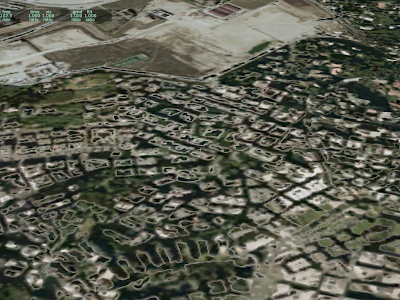
What are these weird artifacts that show up over the terrain when shaders are on? Well, they should (and will in 930) look like this:
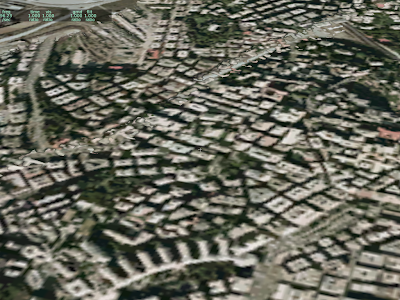
But what’s going on? The answer is auto-variation.
In X-Plane 8, variation is created by using multiple layers, each one applying a texture at a different offset. This technique works on a wide range of hardware, but is inefficient – it causes overdraw (which we know is
very bad).
So in X-Plane 9 I replaced this layer-based variation with a pixel shader algorithm. This means less information in the DSF (which means smaller DSFs, faster loading and less RAM use), but it also means variation is only visible to those with shaders. Having the pixel shaders create variation dynamically on the GPU is called “auto-variation” (and is invoked via the AUTO_VARY command in a .ter file).
The artifact above was a bug in the auto-variation shader. With the code now fixed (the 930 patch will contain the fix), here are some images of how it is supposed to work:
Here we have the texture in question, at two different offsets.
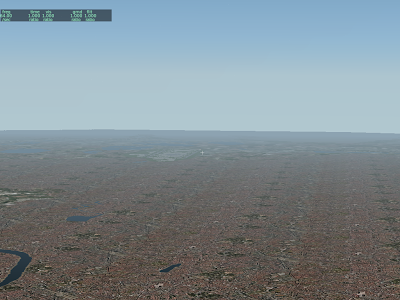

This black and white texture is the “mixing mask” used to select which offset to use.
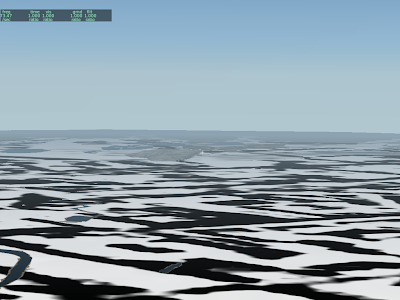
And this is the final result.
There is a little bit more disruption in the columns of green park.
I was going to post some pictures of the newly fixed “auto-vary” feature, but before I can do that in a way that makes any sense, I need to explain how X-Plane deals with texture repetition.
Texture repetition is the inevitable result of using “landuse-style” texturing (that is, a repeating single texture representing a type of land). Typical X-Plane land use textures are 1024 x 1024 at max res and repeat about every 3-5 km. Unfortunately, our brains are pattern-recognizing machines, and the result of this texturing scheme is that the “grid lines” of texture placement become apparent over wide views.
We use a number of techniques to minimize this problem.
Lots of Land Uses
Our main tool to combat repetition is to not use a given land use for too large of an area. This has the advantage of efficiently using the entire set of textures, and (because terrain textures change based on an irregular grid, based on elevation) the changes to textures are both irregular in shape and “plausible” in placement.
In this picture, you can see that the urban residential land use has been interrupted by various forest and grass textures. This is intentional – Sergio tuned hte land use rules to make sure that we wouldn’t have large regions of one land use type. Those blobs match the irregular grid, which gets its shape from the terrain’s elevation.
Variation
In the above picture, you can still see the repeating grid of the residential terrain; observe the right side – you’ll see the same repeating vertical pattern of road repeating over and over. In order to further hide repetition, we use the same texture multiple times, but in offset locations.
Here you can see that the vertical line on the right side has been broken up a bit.
More VRAM
In some cases, a terrain covers such large areas despite the rule set (e.g. for really flat areas) that we use two separate textures and can vary between them. Here you can see both input textures for our dry square crop land use, as well as the combined results.
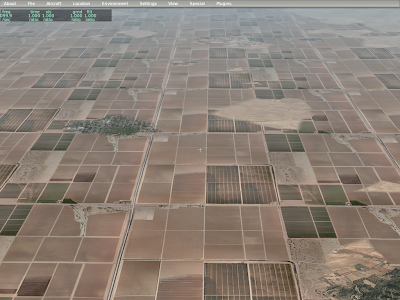
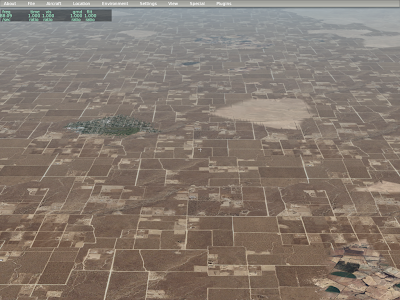
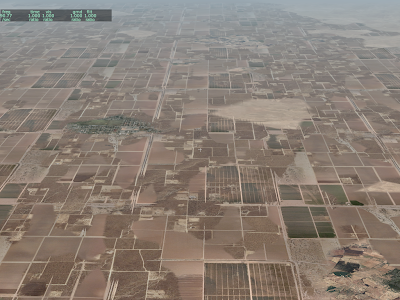
In summary, we have three techniques:
- Add more rules to prevent large spans of a single land-use.
- Use a texture with multiple offsets (variation)
- Use two textures and vary between them.
The apt.dat 850 file format defines a polygonal “airport boundary”. But what exactly does it do? It does different things when creating DSFs and when rendering them.
Inside X-Plane it has relatively little effect:
- It is one of many elements that counts toward the land area that will be flattened. (Runways and taxiways are also used.)
- We do not actually render any special terrain or fences.
The airport boundary has more of an effect during scenery creation.
- If an airport has an airport boundary, we do not calculate the airport’s boundary ourselves – instead f we use the specified boundary.
- All land intersecting the airport boundary is turned to airport terrain.
- The DEM is flattened within the airport boundary to reduce the slope of high frequency bumps.
There is one aspect of airport creation that the airport boundary is not involved in: filling in water to make land under runways. When we create an airport, we actually calculate three boundary polygons:
- The inner ring is closest to runways and taxiways (very close) with very little simplification. It is filled in with land if it is wet.
- A second ring slightly farther from runways and taxiways is also filled in with land if it is wet.
- The outermost ring is a lot farther out, but does not fill in Water. This is the ring that the airport boundary can replace.
Why do we need two inner rings? Well, if an airport is next to the water but not at sea level, we need to induce two sets of mesh points, the outer ones which drop down to sea level and the inner ones which are at airport level. You can see the importance of this at KLGA, where one of the runways dropped to sea level at its midpoint in version 8, but not version 9.
Since the airport boundary polygon provides only one ring, it cannot be used for this purpose. At some point in the future, we might use the airport boundary for rings 2 and 3, or use a smaller version of the airport polygon for rings 1 and 2.
For now, my recommendation is: the airport boundary should trace out the entire airport premesis, not including water.
This thread on X-Plane.org sparked off quite the discussion. Now a lot of this is a discussion of when LR will have an overlay editor – there are a few overlay editing functions that Jonathan Harris’ excellent OverlayEditor apparently does not yet support, sparking this discussion.
(I am not saying that LR should rely on Jonathan to do an overlay editor. But I am saying that the complaints I hear about a lack of overlay editing go down when Jonathan’s overlay editor does everything that the file formats can do.)
But another part of the discussion focused on the problem of mesh editing. In particular, the basic terrain in a DSF is a fully baked output of a complex process that starts with higher level GIS input data. In other words, we start with a raster DEM, polygon coastline, apt.dat file, vector roads, and a bunch of config files and hit “bake” and a DSF comes out the other side, with a lot of processing.
This is very different than FS X, which integrates its data sources on the fly. Why did we choose a precomputed route for scenery? It has some pros and cons. (In understanding how we made these decisions, think back to what scenery was like with X-Plane 7 and ENVs and single-core machines.)
Performance
The main benefits of preprocessing scenery are performance related. When you process scenery data into the final scenery while flying, that computer power takes away from the rendering engine, thus cutting down fps. At some point you have a zero-sum game between how much cost there is to loading scenery and how complex the scenery integration can be; you have to pick very simple scenery integration algorithms to keep fps up.
(This is less of an issue as more cores become available, but is still a factor.)
When pre-processing, we can use algorithms that take minutes per DSF without affecting framerate.
Similarly, there might be scenery processing algorithms that improve fps by optimizing the output triangles – but do we have time to run these algorithms during load? With preprocessing we have all the time in the world because it happens once before the DVDs are burned.
Preprocessing also breaks a similar zero sum game between scenery data size and quality; the source data we use to make the scenery is a lot bigger than the 78 GB of DSFs we cut; if we had to ship the source data, we’d have to cut down the source data quality to hit our DVD limitations. With be-baking we could use 500 GB of source data without penalty.
Format Flexibility and Stability
The second set of benefits to preprocessing are flexibility benefits. (Consider the file format churn of the ENV days.)
– With a preprocessed scenery file, what the author creates is what the user sees – X-Plane does not go in and perform subjective integrations on the scenery later that might change how it looks in a negative way.
- There is no need to revise the scenery file formats to introduce new data sets, because new data sets and old are all processed to the same final DSF container format.
- A wide variety of mesh generation techniques can be employed because the mesh generation is not built into X-Plane. This is a flexibility that I don’t think anyone has really utilized.
- Changes of behavior in the scenery generation toolset can never affect existing scenery because that scenery is already preprocessed; this help compatibility of old file formats.
Integration Issues
There are some real limitations to a pre-processed format, and they are virtually all in the bucket of “integration issues” – that is, combining separate third party add-ons to improve scenery. In particular, in any case where we preprocess two data sources, we lose the opportunity for third parties to provide new scenery to replace one of those data sources and not the other.
Airport is the achilles heal where this hurts us most; while airport layouts are overlays and can be added separately to the scenery system, the elevation of the base mesh below the airport needs to be preprocessed. This is something I am still investigating – a tolerable fix that other shave proposed is to allow an overlay scenery pack to flatten a specific region regardless of the user setting (so an author can be assured of a flat base to work from).
Preprocessing does fundamentally limit the types of third party add-ons that can be done; with version 9 and overlay roads, we are getting closer to letting road add-ons be overlays (see this post).
It appears to me that integration isn’t the primary complaint about the scenery system (the primary complaint is lack of tools) but we’ll have to see once we have mesh editing tools (mesh recreation tools really) whether preprocessing still limits certain kinds of scenery.
Note that a lack of tools or a lack of tool capability is not an inherent limitation of pre-processed scenery. We have an incomplete tool set because I have not written the code for a complete tool set, not because it cannot be done.
(The complexity of writing base mesh editing tools is a function of the complexity of a vector-based base mesh – this is also not related to pre-processing per se.)
Tools
In the end, I think the question of tools is not directly tied to the question of pre-processing. Whether we have scenery that is processed by X-Plane or a preprocessing tool, we have the same issues:
- Good tools require an investment in coding user interface.
- The code to convert source data which users might want to edit (like a polygon that defines a lake) to data the simulator might want to use (like a list of 78,231 triangles) has to be written.
I don’t think either option (pre-processing or in-simulator processing) reduces the amount of work to be done to create a good toolset.
As a final thought, using scenery file formats that are “easier to edit” (e.g. a file format that contains a polygon for water rather than triangles) doesn’t make the total code for scenery tools + simulator any easier; it just moves the task of “processing” the scenery from the tools to the simulator itself.
Per-pixel lighting is something I hope to have in X-Plane soon. A number of other features will take longer, and quite possibly might never happen. This is the “pie in the sky” list – with this list, we’re looking at higher hardware requirements, a lot of development time, and potential fundamental problems in the rendering algorithm!
High Dynamic Range (HDR) Lighting
HDR is a process whereby a program renders its scene with super bright and super dark regions, using a more detailed frame-buffer to draw. When it comes time to show the image, some kind of “mapping” algorithm then represents that image using the limited contrast available on a computer monitor. Typical approaches include:
- Scaling the brightness of the scene to mimic what our eyes do in dark or bright scenes.
- Creating “bloom”, or blown out white regions, around very bright areas.
Besides creating more plausible lighting, the mathematics behind an HDR render would also potentially improve the look of lit textures when they are far away. (Right now, a lit and dark pixel are blended to make semi-lit pixels when far away as the texture scales down. If a lit pixel can be “super-bright” it will still look bright even after such blending.)
Besides development time, HDR requires serious hardware; the process of drawing to a framebuffer with the range to draw chews up a lot of GPU power, so HDR would be appropriate for a card like the GeForce 8800.
While there aren’t any technical hurdles to stop us from implementing HDR, I must point out that, given a number of the “art” features of X-Plane like the sun glare, HDR might not be as noticeable as you’d think. For example, our sun “glares” when you look at it (similar to an HDR trick), but this is done simply by us detecting the view angle and drawing the glare in.
Reflection Mapped Airplanes
Reflection maps are textures of the environment that are mapped onto the airplane to create the appearance of a shiny reflective surface. We already have one reflection map: the sky and possibly scenery are mapped onto the water to create water reflections.
Reflection maps are very much possible, but they are also very expensive; we have to go through a drawing pass to prepare each one. And reflection maps for 3-d objects like airplanes usually have to be done via cube maps, which means six environment maps!
There’s a lot of room for cheating when it comes to environment maps. For example: rendering environment maps with pre-made images or with simplified worlds.
Shadows
Shadows are the biggest missing feature in the sim’s rendering path, and they are also by far the hardest to code. I always hesitate to announce any in-progress code because there is a risk it won’t work. But in this case I can do so safely:
I have already coded global
shadow maps, and we are not going to enable it in X-Plane. The technique just doesn’t work. The code has been ripped out and I am going to have to try again with a different approach.
The problem with shadows is the combination of two unfortunate facts:
- The X-Plane world is very, very big and
- The human eye is very, very picky when it comes to shadows.
For reflections, we can cheat a lot — if we don’t get something quite right, the water waves hide a lot of sins. (To work on the water, I have to turn the waves completely off to see what I’ m doing!) By comparison, anything less than perfect shadows really sticks out.
Shadow maps fail for X-Plane because it’s a technology with limited resolution in a very large world. At best I could apply shadows to the nearest 500 – 1000 meters, which is nice for an airport, but still pretty useless for most situations.
(Lest someone send the paper to me, I already tried “TSM” – X-Plane is off by about a factor of 10 in shadow map res; TSM gives us about 50% better texture use, which isn’t even close.)
A user mentioned
stencil shadow volumes, which would be an alternative to shadow maps. I don’t think they’re viable for X-Plane; stencil shadow volumes require regenerating the shadow volumes any time the relative orientation of the shadow caster and the light source change; for a plane in flight this is every single plane. Given the complexity of planes that are being created, I believe that they would perform even worse than shadow maps; where shadow maps run out of resolution, stencil shadow volumes would bury the CPU and PCIe bus with per-frame geometry. Stencil shadow volumes also have the problem of not shadowing correctly for alpha-based transparent geometry.
(Theoretically geometry shaders could be used to generate stencil shadow volumes; in practice, geometry shaders have their own performance/throughput limitations – see below for more.)
Shadows matter a lot, and I am sure I will burn a lot more of my developer time working on them. But I can also say that they’re about the hardest rendering problem I’m looking at.
Dynamic Tessellation
Finally, I’ve spent some time looking at graphics-card based tessellation. This is a process whereby the graphics card splits triangles into more triangles to make curved surfaces look more round. The advantage of this would be lower triangle counts – the graphics card can split only the triangles that are close to the foreground for super-round surfaces.
The problem with dynamic tessellation is that the performance of the hardware is not yet that good. I tried implementing tessellation using geometry shaders, and the performance is poor enough that you’d be better off simply using more triangles (which is what everyone does now).
I still have hopes for this; ATI’s Radeon HD cards have a hardware tessellator and from what I’ve heard its performance is very good. If this kind of functionality ends up in the DirectX 11 specification, we’ll see comparable hardware on nVidia’s side and an OpenGL extension.
(I will comment more on this later, but: X-Plane does not use DirectX – we use OpenGL. We have no plans to switch from OpenGL to DirectX, or to drop support for Linux or the Mac. Do not panic! I mention DirectX 11 only because ATI and nVidia pay attention to the DirectX specification and thus functionality in DirectX tends to be functionality that is available on all modern cards. We will use new features when they are available via OpenGL drivers, which usually happens within a few months of the cards being released, if not sooner.)
My previous post on scenery tools stirred up some discussion; y-man brought up a point fundamental enough that I think it warrants explanation.
The questions is whether to fix broken DSFs by editing the source data or the DSFs themselves.
Let me be clear: both are viable options, both have limitations, and neither are possible today. So in choosing one over the other, I am picking a strategy that I think is superior, and discounting the other not because I think it is useless, but because it is less useful and development time is very limited (doing both would take away from other good features).
Basically the two ways to fix a DSF are:
- Edit the DSF itself until it looks correct.
- Edit the source data and then rebuild the DSF from scratch.
I strongly believe we must pursue the second strategy for this simple reason: if we correct a DSF but don’t fix the source data, the same mistakes will be made in the future.
We have to keep recutting the global scenery to keep up with:
- Higher capacities for detail in newer computers.
- New global data that becomes available.
- Improved generation algorithms that makes better results from existing data.
To lose any of these would be a big set-back in scenery quality, so not recutting DSFs isn’t a great option. (Furthermore, improvements in scenery often come from new global data, so picking user changes over new data would be a tough choice.)
By letting users change the source data, we can have the best of both worlds: problems are fixed while new technology is adopted.
To answer y-man’s direct questions:
But that data is not available to us users is it? If it is, where is it, and where is the spec to work with it?
It is not available yet! I am proposing to focus on making the data available and creating the infrastructure to share data and receive improvements (choice 2) rather than providing a DSF mesh editor (choice 1).
Alternatively, a user who goes thru the trouble of correcting base DSF could send in the modified DSF, or may be even a diff between before and after states of DSF text files, and attach an explanation of purpose.
Here’s the problem: we can’t preserve the diff to the DSF and apply it to future renderings.
Imagine, or example, that you relocate 500 mesh vertices from the existing DSFs to correct a coastline. (I am being generous here and assuming a clear, single, unifying edit. But some authors would more likely move the vertices to make a number of improvements.)
In the meantime, another author creates an airport nearby, and someone else improves the SRTMs (there is at least one person attributed in our about box who has been collecting void-filled SRTM tiles). The effect of the nearby airport’s pavement changing size and the raw elevation changing height is to change greatly how the mesh is generated, such that 400 of the 500 vertices that were moved simply no longer exist, and 450 new vertices are in the nearby area now that were not in the original DSF.
This case is known as a “merge conflict” in computer programming terms (and happens when two changes to a program are “merged”). The problem is that we can’t sanely know what to do with our 500 edited vertices in this case. Do we take the 100 vertices that still exist and move them without the others? What if that produces very strange results? (Triangles might become inside-out because some vertices are moved a lot but their neighbors are not because they did not match the diff.)
We could try to apply some kind of change to the new vertices similar to what happened to the old, but how do we know if this is making things better or worse? What if that change simply deforms the outline of the airport that was added?
I can go on and on with these kinds of examples, but the point is this: you can’t unbake a cake. A DSF is similar; you can’t necessarily recover the sources that were processed together to form the final product.
This is why it’s important that we create infrastructure to correct source data, rather than focus on editing the final DSFs. I can assure you that my negative attitude toward editing DSFs is not a negative attitude toward user participation!
There are still a lot of details to be worked out about how we can work together. Who will own the data, and on what terms? How will it be distributed? How will it be shared?
Unfortunately I can’t answer those questions yet. I still need to do more research into what is technologically possible – then we can figure out how to proceed.
WED 1.0 has gone RC. The on ly change from beta 5 is that I have the latest manual changes from Tom (including Cormac’s illustrations of taxiway signs). Both of them did some great work – the WED manual is a lot nicer than the docs I have done myself for the other tools.
ly change from beta 5 is that I have the latest manual changes from Tom (including Cormac’s illustrations of taxiway signs). Both of them did some great work – the WED manual is a lot nicer than the docs I have done myself for the other tools.
A while ago I posted a tools update…has anything changed? Not a whole lot.
- WED is definitely the future of the “heavy” scenery tools (ones with extensive UI) – it has a lot of infrastructure for features like multiple undo, multiple selection, hiearchial editing, etc.
- The next big feature for WED will be some kind of overlay editing. I don’t think this will happen very soon though – my todo list is pretty out of control.
- In the long term, I think WED may provide a visual way to do MeshTool-like operations. In other words, you’ll be able to build a base mesh in WED by specifying polygons for airports, applying orthophotos, and importing one big DEM per tile.
- I don’t think that WED will ever be a DSF editor – that is, you won’t be able to open an existing DSF, move a single node, and re-save it. This just isn’t high on my priority list.
To this last point, how are you supposed to fix scenery if you can’t edit DSFs? Well, I’ll try to post more on that over the next few weeks, but the short answer is that we need structured edits to source data.
A DSF is a compiled result of a very complex set of processes. The vertex that you adjust in the mesh to fix a mountain top may not exist in the DSF if another user submits an updated airport layout, even if they are fifty kilometers apart. (All parts of the DSF affect each other through the adaptive irregular mesh.) So I don’t want to take user submitted corrections to the final DSF because those changes would be lost at the next render.
We’ve been down this road before – when the V6 global scenery was done, the plan was: now we’ll take user-edited ENVs. The problem was that this plan assumed that we’d never re-render the ENVs again, which proved totally wrong – we re-rendered them at the end of the v6 run with improved algorithms.
What we need to do is identify what components of the source data are reasonable candidates for user editing, and set up processes (similar to Robin’s collection of apt.dat data) to gather data and share it.
(We are looking at OSM – it is still under investigation!)
There will be a lot more to post about this soon…a few immediate comments:
We have an order in with one of our server providers to get a lot more bandwidth for demo/update downloading…the servers are going to be pretty slammed, but we’re doing our best to keep downloads fast. I believe the beta should be about 600 – 700 MB over the net.
X-Plane beta 1 is on the DVD. X-Plane beta 2 is on the net. In other words, we’ve already done our first patch since the DVDs went master. This patch improves performance and fixes QuickTime movie recording on Windows. (BTW QT movie recording is completely overhauled for version 9.) So once you get DVDs, make sure to run the web updater to get beta 2. With a DVD install this is a tiny download, since the updater only fetches changed files.
The DVD set is “X-Plane 9 beta 1”, but the scenery and terrain/earth orbit textures are final. So you can buy DVDs now and simply use the web updater to get the “final” X-Plane 9.00 (plus of course all of the free upgrades and patches for the life of version 9).
This is the first major version release where we’ve had our updater. In the past we’ve had to either post a new version without a beta, or put a beta on DVD. With X-Plane 9, the large files that aren’t available for web updating are finished, and the rest of the beta can be upgraded over the net. I hope this allows people to participate in the beta program and still enjoy the sim with full scenery.












